Radical Faeries

 Clash Royale CLAN TAG#URR8PPP
Clash Royale CLAN TAG#URR8PPP
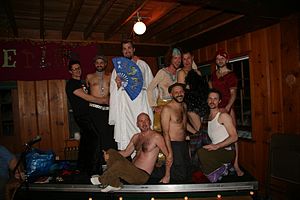
Faeries at Breitenbush gathering
The Radical Faeries are a loosely affiliated worldwide network and countercultural movement seeking to redefine queer consciousness through secular spirituality.[1] Sometimes deemed a form of modern Paganism, the movement also adopts elements from anarchism and environmentalism.
Rejecting hetero-imitation, the Radical Faerie movement began during the 1970s sexual revolution among gay men in the United States.[2] The movement has expanded in tandem with the larger gay rights movement, challenging commercialization and patriarchal aspects of modern LGBT life while celebrating eclectic constructs and rituals.[3] Faeries tend to be fiercely independent, anti-establishment, and community-focused.[3]
The Radical Faerie movement was founded in California in 1979 by gay activists Harry Hay, Mitch Walker, John Burnside, and Don Kilhefner, who wanted to create an alternative to what they saw as the assimilationist attitude of the mainstream U.S. gay community. Influenced by the legacy of the counterculture of the 1960s, they held the first Spiritual Conference for Radical Fairies in Arizona in September 1979. From there, various regional Faerie Circles were formed, and other large rural gatherings organized. Although Walker and Kilhefner broke from Hay in 1980, the movement continued to grow, having expanded into an international network soon after the second Faerie gathering in 1980.
Today Radical Faeries embody a wide range of genders, sexual orientations, and identities. Sanctuaries and gatherings are generally open to all, though several gatherings still focus on the particular spiritual experience of man-loving men co-creating temporary autonomous zones.[4] Faerie sanctuaries adapt rural living and environmentally sustainable concepts to modern technologies as part of creative expression.[3] Radical Faerie communities are sometimes inspired by indigenous, native or traditional spiritualities, especially those that incorporate genderqueer sensibilities.[5]
Contents
1 Philosophy and ritual
2 History
2.1 Foundation: 1978–79
2.2 Growth, friction, and split: 1979–80
2.3 Continued growth: 1981–present
3 Sanctuaries and gatherings
4 Cultural influence
5 See also
6 Bibliography
6.1 Periodicals
7 References
7.1 Notes
7.2 Footnotes
7.3 Bibliography
8 External links
Philosophy and ritual
.mw-parser-output .quoteboxbackground-color:#F9F9F9;border:1px solid #aaa;box-sizing:border-box;padding:10px;font-size:88%.mw-parser-output .quotebox.floatleftmargin:0.5em 1.4em 0.8em 0.mw-parser-output .quotebox.floatrightmargin:0.5em 0 0.8em 1.4em.mw-parser-output .quotebox.centeredmargin:0.5em auto 0.8em auto.mw-parser-output .quotebox.floatleft p,.mw-parser-output .quotebox.floatright pfont-style:inherit.mw-parser-output .quotebox-titlebackground-color:#F9F9F9;text-align:center;font-size:larger;font-weight:bold.mw-parser-output .quotebox-quote.quoted:beforefont-family:"Times New Roman",serif;font-weight:bold;font-size:large;color:gray;content:" “ ";vertical-align:-45%;line-height:0.mw-parser-output .quotebox-quote.quoted:afterfont-family:"Times New Roman",serif;font-weight:bold;font-size:large;color:gray;content:" ” ";line-height:0.mw-parser-output .quotebox .left-alignedtext-align:left.mw-parser-output .quotebox .right-alignedtext-align:right.mw-parser-output .quotebox .center-alignedtext-align:center.mw-parser-output .quotebox citedisplay:block;font-style:normal@media screen and (max-width:360px).mw-parser-output .quoteboxmin-width:100%;margin:0 0 0.8em!important;float:none!important
Margot Adler, 2006.[6]
Hay's biographer Stuart Timmons described the Faeries as a "mixture of a political alternative, a counter-culture, and a spirituality movement."[7] Peter Hennan asserted that the Faeries contained elements of "Marxism, feminism, paganism, Native American and New Age spirituality, anarchism, the mythopoetic men's movement, radical individualism, the therapeutic culture of self-fulfillment and self-actualization, earth-based movements in support of sustainable communities, spiritual solemnity coupled with a camp sensibility, gay liberation and drag." [8]
The Radical Faerie movement was a reaction against the social emptiness that many gay men felt was present both in the heterosexual establishment and the assimilationist gay community.[9] As one Faerie commented, in his opinion mainstream gay culture was "an oppressive parody of straight culture", taking place primarily in bars and not encouraging people to "form bonds or care for each other". In contrast, the Faeries "live their sexuality in a way that is very connected to the earth."[10]
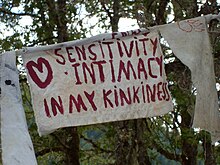
A Faerie banner
Faeries represent the first spiritual movement to be both "gay centered and gay engendered", where gayness is central to the idea, rather than in addition to, or incidental to a pre-existing spiritual tradition. The Radical Faerie exploration of the "gay spirit" is central, and that it is itself the source of spirituality, wisdom, and initiation. Founding Faerie Mitch Walker claims that "because of its indigenous, gay-centered nature, the Radical Faerie movement pioneers a new seriousness about gayness, its depth and potential, thereby heralding a new stage in the meaning of Gay Liberation."[11]
In keeping with hippie, neopagan, and eco-feminist trends of the time, gatherings were held out-of-doors in natural settings.[12] To this end, distinct Radical Faerie communities have created sanctuaries that are "close to the land".[13]
In her study of the Pagan movement in the U.S., journalist Margot Adler noted that the Faeries placed a great emphasis on the "transformative power of play", believing that playful behavior had a role within ritual that could lead to an altered state of consciousness. In keeping with this, they were often the "public anarchists" at Pagan events, challenging the formalized ritual structures propagated by other Pagans; at one event in the 1980s, a group of Faeries stood at the entrance to the ritual circle, calling out "Attention! No spontaneity! We're the spontaneity police!" as a way of parodying what they saw as formalised trends within Pagan ritual.[14] Adler also noted similar trends within other Pagan groups, such as the Reformed Druids of North America and the Erisian movement.[15]
History
Before the Radical Faeries were started or there was any talk about the faeries, there had been many studies done by psychologists and other scientists on gay religion.[16] The Radical Faerie movement emerged from the counterculture of the 1960s, which had created a wider cultural drift and encouraged greater experimentation in spiritual matters throughout the English-speaking world, in particular in United States, Australia, Canada and Western Europe.[17] There were some gay-oriented spiritual movements that preceded the Radical Faeries; in 1976, the gay activist and writer Arthur Evans founded "the Faery Circle" in his Haight Street apartment in San Francisco, in which he and twelve other gay men followed a form of gay-oriented contemporary Paganism devoted to the god Dionysus.[17][18] Evans would go on to publish his ideas on the spiritual history of gay men in the gay magazines Out and Fag Rag and the book Witchcraft and the Gay Counterculture (1978).[19] Evans' work would be cited as an influence on a number of Radical Faeries.[20] Another influence was the Whole Earth Catalog, an American counterculture catalog published by Stewart Brand between 1968 and 1972, and occasionally thereafter, until 1998; the catalogs listed all sorts of products for sale that were useful for a creative or self-sustainable lifestyle. Another key influence was the RFD Collective, which had been founded in Iowa in 1974. Encouraging a back-to-the-land ethos among gay men, it critiqued the "adamant heterosexuality" of existing rural magazines and so began publishing RFD: A Magazine for Country Faggots.[21] Gay rights activist Harry Hay had first published an article in RFD in 1975, which he had devoted to his recently deceased mother.[22]
Foundation: 1978–79
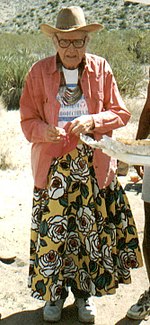
Harry Hay, a founder of the Radical Faerie movement, in 1996
The Radical Faerie movement was founded by a cabal of three gay men: Harry Hay, Don Kilhefner, and Mitch Walker.[23] Hay was a veteran of gay rights activism, having been a longstanding activist in the Communist Party USA prior to becoming a founding member of the Mattachine Society in 1950. After being publicly exposed as a Marxist in 1953, Hay stepped down from the Society's leadership, shortly before the other founders were forced to resign by more conservative members. Hay continued his involvement in gay activism, involving himself in the foundation of the Los Angeles branch of the Gay Liberation Front (GLF) in 1969, before leaving this to move to New Mexico.[24] Walker was from a middle-class Jewish household in Hawthorne, California, and went on to study psychology at UCLA, focusing on Jungian psychology. For his master's thesis at Lone Mountain College he proposed a gay sex guide containing historical information and psychological reassurance; the concept was rejected by the faculty committee but was subsequently published as Men Loving Men: A Gay Sex Guide and Consciousness Book (1977). Describing himself as "a gay shaman", he was subsequently introduced to Hay in 1976.[25]
Raised into an Amish-Mennonite community, Kilhefner had studied at Howard University where he joined the anti-Vietnam War movement and the Student Nonviolent Coordinating Committee. After university, he spent time in Ethiopia with the Peace Corps before joining the Peace and Freedom Party and becoming a leading figure in the GLF from 1969 to 1971.[23] As the GLF evolved into the L.A. Gay Community Services Center, Kilhefner became its first executive director. As it grew, it sought the support of wealthy gay people to finance its social work and public relations, with Kilhefner being concerned at its increasingly assimilationist stance and taking a leave of absence in 1976. He proceeded to enter into a retreat run by Baba Ram Dass, where he got into an extended conversation with Hay in May 1978.[26]
In Autumn 1978, the therapist Betty Berzon invited the three men to lead a workshop on "New Breakthroughs in the Nature of How We Perceive Gay Consciousness" at the annual conference of the Gay Academic Union, held at the University of Southern California in Los Angeles.[27] This event convinced Hay and his partner John Burnside that they should leave their home in New Mexico and move to Los Angeles, where they settled into a 1920s house on the eastern edge of Hollywood.[28] The three then decided to organise an outdoor conference at which they could teach other gay men about their ideas regarding gay consciousness. Kilhefner identified an ideal location from an advert in The Advocate; the Sri Ram Ashram was a gay-friendly spiritual retreat in the desert near Benson, Arizona, owned by an American named Swami Bill.[29] Hay, Kilhefner, and Walker visited to check its suitability, and although Hay disliked Bill and didn't want to use the site, the others insisted.[29]
Fritz Frurip on the first Faery gathering.[30]
Their conference, set for Labor Day 1979, was to be called the "Spiritual Conference for Radical Fairies",[31][note 1] with the term "Radical Faerie" having been coined by Hay. The term "Radical" was chosen to reflect both political extremity and the idea of "root" or "essence", while the term "Faerie" was chosen in reference both to the immortal animistic spirits of European folklore and to the fact that "fairy" had become a pejorative slang term for gay men.[32] Initially, Hay rejected the term "movement" when discussing the Radical Faeries, considering it to instead be a "way of life" for gay males, and he began referring to it as a "not-movement".[33] In organising the event, Hay handled the political issues, Burnside the logistics and mechanics, Kilhefner the budgetary and administrative side, and Walker was to be its spiritual leader.[34] A flier advertising the event was released which proclaimed that gays had a place in the "paradigm shift" of the New Age, and quoted Mark Satin and Aleister Crowley alongside Hay; these fliers were sent out to gay and leftist bookstores as well as gay community centres and health food stores.[35]
Around 220 men turned up to the event, despite the fact that the Ashram could only accommodate around 75.[36] Hay gave a welcoming speech in which he outlined his ideas regarding Subject-SUBJECT consciousness, calling on those assembled to "throw off the ugly green frogskin of hetero-imitation to find the shining Faerie prince beneath".[36] Rather than being referred to as "workshops", the events that took place were known as "Faerie circles",[36] and were on such varied subjects as massage, nutrition, local botany, healing energy, the politics of gay enspiritment, English country dancing, and auto-fellatio.[37] Those assembled took part in spontaneous rituals, providing invocations to spirits and performing blessings and chants,[36] with most participants discarding the majority of their clothes, instead wearing feathers, beads, and bells, and decorating themselves in rainbow makeup.[30] Many reported feeling a change of consciousness during the event, which one person there described as "a four day acid trip – without the acid!".[38] On the final night of the gathering, they put together a performance of the Symmetricon, an invention of Burnside's, while Hay gave a farewell speech.[39]
Growth, friction, and split: 1979–80
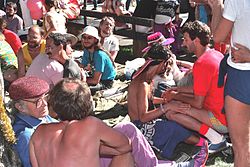
A Faerie gathering in 1986, with Hay in bottom left corner
After Hay and the others returned to Los Angeles, they received messages of thanks from various participants, many of whom asked when the next Faerie gathering would be.[40] Hay decided to found a Faerie circle in Los Angeles that met at their house, which became known as "Faerie Central", devoting half their time to serious discussion and the other half to recreation, in particular English circle dancing. As more joined the circle, they began meeting in West Hollywood's First Presbyterian Church and then the olive grove atop the hill at Barnsdall Park; however they found it difficult to gain the same change of consciousness that had been present at the rural gathering.[41] The group began to discuss what the Faerie movement was developing into; Hay encouraged them to embark on political activism, using Marxism and his Subject-SUBJECT consciousness theory as a framework for bringing about societal change. Others however wanted the movement to focus on spirituality and exploring the psyche, lambasting politics as part of "the straight world".[42] Another issue of contention was over what constituted a "Faery"; Hay had an idealized image of what someone with "gay consciousness" thought and acted like, and turned away some prospective members of the Circle because he disagreed with their views. One prospective member, the gay theatre director John Callaghan, joined the circle in February 1980, but was soon ejected by Hay after he voiced concern about hostility toward heterosexuals among the group.[43]
The second Faerie gathering took place in August 1980 in Estes Park near Boulder, Colorado. Twice as long and almost twice as large as the first, it became known as Faery Woodstock.[44] It also exhibited an increasing influence from the U.S. Pagan movement, as Faeries incorporated elements from Evans' Witchcraft and the Gay Counterculture and Starhawk's The Spiral Dance into their practices.[45] At that gathering, Dennis Melba'son presented a shawl that he had created with a crocheted depiction of the Northwest European Iron Age deity Cernunnos on it; the shawl became an important symbol of the Faeries, and would be sent from gathering to gathering over subsequent decades.[46] There, Hay publicly revealed the founding trio's desire for the creation of a permanent residential Faerie community, where they could grow their own crops and thus live self-sustainably. This project would involve setting up a non-profit corporation to purchase property under a community land tryst with tax-exempt status. They were partly inspired by a pre-existing gay collective in rural Tennessee, Short Mountain.[47] The gathering was also attended by an increasing number of men from outside of America, particularly Canada, but also from Australia, Norway, France and Germany, many of whom returned to their countries of origin to establish Faerie communes, such as the Wellington Boot, Common Ground etc. in Australia.
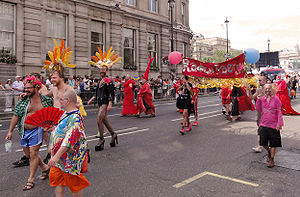
Radical Faeries with banner at 2010 London Gay Pride
There was some antagonism between Hay and Walker from the beginning of their venture, in part stemming from personality differences. It was made worse by their differing approaches to Jungian psychology; Walker saw analytical psychology as central to his world view and believed that it could be utilised to aid the gay movement, whereas Hay was disdainful of it.[48] As the Los Angeles Circle grew, Kilhefner also became annoyed with Hay over the latter's tendency to dominate conversations both in and out of the Circle, as well as his proselytizing attitude.[49] In 1980 Walker secretly formed the "Faerie Fascist Police" to combat "Faerie fascism" and "power-tripping" within the Faeries. He specifically targeted Hay: "I recruited people to spy on Harry and see when he was manipulating people, so we could undo his undermining of the scene."[50]
At a winter 1980 gathering in southern Oregon designed to discuss acquiring land for a Faerie sanctuary, a newcomer to the group, coached by Walker, confronted Harry about the power dynamics within the core circle. In the ensuing conflict, the core circle splintered. Plans for the land sanctuary stalled and a separate circle formed.[51] The core circle made an attempt to reconcile, but at a meeting that came to be known as "Bloody Sunday", Kilhefner quit, accusing Hay and Burnside of "power tripping", while Walker resigned.[52] Walker and Kilhefner formed a new Los Angeles-based gay spiritual group called Treeroots which promoted a form of rural gay consciousness associated with Jungian psychology and ceremonial magic.[53] However, despite the division among its founders, the Radical Faerie movement continued to grow, largely as a result of its egalitarian structure, with many participants being unaware of the squabbles.[54] Hay himself continued to be welcomed at gatherings, coming to be seen as an elder statesman in the movement.[55]
Continued growth: 1981–present
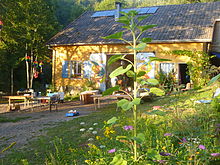
The Folleterre Faerie Sanctuary in France
The first Faerie gathering in Australia was held in January 1981, at Tony Newman's Whole Earth Dream Farm near Ourimbah (established in 1974), inspired by the reporting of the second Faerie gathering in Colorado by RFD, and held in conjunction with Sydney's Gay Men's Rap, although this first gathering did not generate any ongoing Faerie activity. A subsequent and unconnected Faerie gathering was held on 9–12 April 1982, at Mandala, a gay spiritual commune established near Uki in Northern NSW in 1974 by David Johnstone. This second gathering included Faeries who had attended the second and third gatherings in the United States, and led to continued growth of the Radical Faeries in Australia, and repeated attempts to establish Faerie communes, such as Common Ground (Clarence River Valley), and eventually the ongoing commune Faerieland, near Nimbin, NSW.
Guided by Mica Kindman, Lloyd Fair, Cass Brayton, and Will Roscoe, the San Francisco Faerie Circle had formed a non-profit corporation under the name of NOMENUS (varyingly interpreted as "No Men Us", "No Menace", and "No Menus"), supported by Hay. They raised enough money to put a down payment on some land from a 1983 gathering in Napa, however decided against forming a self-sufficient community, instead choosing to purchase a smaller piece of land that could be stationed by a few caretakers and which could house regular gatherings.[56] In 1987 they purchased Magdalene Farm – an 80-acre property near Grant's Pass, Oregon – from George Jalbert, who has unsuccessfully hoped to establish his own rural gay commune there over the preceding decade.[57]
Throughout the 1980s the Radical Faerie movement had spread out from the United States and had gatherings in Canada, Australia, the United Kingdom, and Italy,[58] as well as Folleterre in France.
Black Leather Wings is an organization for spiritual gay leathermen, mostly Pagans, and is a circle within the Radical Faeries.[59] The San Francisco South of Market Leather History Alley consists of four works of art along Ringold Alley honoring leather culture; it opened in 2017.[60][61] One of the works of art is metal bootprints along the curb which honor 28 people (including Mark Thompson, among other things a co-founder of Black Leather Wings, and Alexis Sorel, co-founder of The 15 and Black Leather Wings member), who were an important part of the leather communities of San Francisco.[61][60]
Sanctuaries and gatherings

The Kiss - 2003
Rural land or urban buildings where Faeries come together to live a communal life are called sanctuaries,[3] which may host gatherings from time to time. Faerie spirit has sparked dedicated groups to develop and maintain sanctuaries internationally.
- Australia
Faerieland in New South Wales
- Canada
The Land aka Amber Fox in Ontario
- France
- Folleterre
- Israel and Palestine
- Canaan Faeries
- Thailand
- Asian Faeries
- United Kingdom
- Albion Faeries
- United States of America
Nomenus Wolf Creek in Oregon- Short Mountain in Tennessee
Faerie Camp Destiny in Vermont
Zuni Mountain in New Mexico
Kawashaway in Minnesota
Blue Heron Farm in far upstate New York- Issafella Faergrounds - Oakland, CA
Groundswell Institute - Yorkville, CA
Faeries also collaborate with friends in non-sanctuary, non-Faerie spaces, including Work Hard Stay Hard in rural Tennessee or Queer Magic in urban Oregon.
May Day was a spring time fertility ritual that the Radical Faeries did at sanctuary events to bring in the spring.[62]
Cultural influence
Participants at the 1979 Faerie gathering helped establish the Sisters of Perpetual Indulgence in San Francisco that same year.[63][64]
Faeries were a contributing influence to John Cameron Mitchell's film Shortbus,[65] including the casting of performance artist Justin Vivian Bond.
Queer as Folk episode "Stand Up for Ourselves" features a storyline where the characters Emmett and Michael attend a rural gathering to discover their "inner Faerie."
See also
- Homosexuality and Neopaganism
- LGBT themes in mythology
- Sisters of Perpetual Indulgence
- Subject-SUBJECT consciousness
Bibliography
Walker, Mitch (Winter 1976), "Visionary Love: The Magickal Gay Spirit-Power", Gay Sunshine: A Journal of Gay Liberation (31).mw-parser-output cite.citationfont-style:inherit.mw-parser-output qquotes:"""""""'""'".mw-parser-output code.cs1-codecolor:inherit;background:inherit;border:inherit;padding:inherit.mw-parser-output .cs1-lock-free abackground:url("//upload.wikimedia.org/wikipedia/commons/thumb/6/65/Lock-green.svg/9px-Lock-green.svg.png")no-repeat;background-position:right .1em center.mw-parser-output .cs1-lock-limited a,.mw-parser-output .cs1-lock-registration abackground:url("//upload.wikimedia.org/wikipedia/commons/thumb/d/d6/Lock-gray-alt-2.svg/9px-Lock-gray-alt-2.svg.png")no-repeat;background-position:right .1em center.mw-parser-output .cs1-lock-subscription abackground:url("//upload.wikimedia.org/wikipedia/commons/thumb/a/aa/Lock-red-alt-2.svg/9px-Lock-red-alt-2.svg.png")no-repeat;background-position:right .1em center.mw-parser-output .cs1-subscription,.mw-parser-output .cs1-registrationcolor:#555.mw-parser-output .cs1-subscription span,.mw-parser-output .cs1-registration spanborder-bottom:1px dotted;cursor:help.mw-parser-output .cs1-hidden-errordisplay:none;font-size:100%.mw-parser-output .cs1-visible-errorfont-size:100%.mw-parser-output .cs1-subscription,.mw-parser-output .cs1-registration,.mw-parser-output .cs1-formatfont-size:95%.mw-parser-output .cs1-kern-left,.mw-parser-output .cs1-kern-wl-leftpadding-left:0.2em.mw-parser-output .cs1-kern-right,.mw-parser-output .cs1-kern-wl-rightpadding-right:0.2em. Republished in Thompson (1987).
Mitchell, Larry (1977), The Faggots & Their Friends Between Revolutions, with drawings by Ned Asta, Calamus Books, ISBN 978-0-930762-00-1
Evans, Arthur (1978), Witchcraft and the Gay Counterculture: A Radical View of Western Civilization and Some of the People It Has Tried to Destroy, Fag Rag Books, ISBN 0-915480-01-8
Thompson, Mark, ed. (1987), Gay Spirit: Myth and Meaning, St. Martin's Press, ISBN 978-1-59021-024-6
Conner, Randy P. (1993), Blossom of Bone: Reclaiming the Connections between Homoeroticism and the Sacred, HarperSanFrancisco, ISBN 0-06-250903-9
Hennen, Peter (2008), Faeries, Bears, and Leathermen: Men in Community Queering the Masculine, University of Chicago Press, ISBN 978-0-226-32727-3
Thompson, Mark, ed. (2011), The Fire in Moonlight: Stories from the Radical Faeries, 1975-2010, with Richard Neely (Osiris) and Bo Young, foreword by Will Roscoe, White Crane Books, ISBN 978-1-59021-338-4
Periodicals
R.F.D., often dubbed the Radical Faerie Digest
White Crane, a journal of Gay Wisdom & Culture
References
Notes
^ Hay and others switched to the older spelling, "faeries", after 1979.
Harry Hay (1996) Radically Gay: Gay Liberation in the Words of its Founder, edited by Will Roscoe.
Footnotes
^ Carroll, Rory; Holpuch, Amanda (28 June 2015). "Hold the applause for Facebook's rainbow-colored profiles, activists say". The Guardian. London. Retrieved 28 June 2015.
^ Thompson, Mark (21 January 2003), "Remembering Harry", The Advocate, Here Publishing, retrieved 2008-10-17
^ abcd Morgensen, Scott. 2009. "Back and Forth to the Land: Negotiating Rural and Urban Sexuality Among the Radical Faeries." In Ellen Lewin and William L. Leap eds. Out in Public: Reinventing Lesbian / Gay Anthropology in a Globalizing World: Readings in Engaged Anthropology. John Wiley and Sons.
ISBN 1-4051-9101-5,
ISBN 978-1-4051-9101-2.
^ Gallagher, Eugene V.; Ashcraft, W. Michael (2006), Introduction to New and Alternative Religions in America, Greenwood Publishing Group, p. 260, ISBN 0-275-98712-4
^ Encyclopedia of lesbian, gay, bisexual, and transgender history in America Marc Stein, Editor; Charles Scribner's Sons, 2004;
ISBN 0-684-31264-6,
ISBN 978-0-684-31264-4.
^ Adler 2006, p. 361.
^ Timmons 1990, p. 249.
^ Hennen, Peter (2008), Faeries, Bears, and Leathermen, University of Chicago Press
^ Timmons 1990, pp. 248–249.
^ Adler 2006, p. 358.
^ Walker, Mitch (Fall 1997), "Contradictory Views on Radical Faerie Thought", White Crane Journal, 34, archived from the original on 1999-08-19
^ Thompson, Mark (2004), Leatherfolk: Radical Sex, People, Politics, And Practice, Daedalus Publishing, p. 282, ISBN 1-881943-20-8
^ Haggerty, George (2000), Gay histories and cultures: an encyclopedia, 2, Taylor & Francis, p. 1123, ISBN 0-8153-1880-4
^ Adler 2006, p. 362.
^ Adler 2006, pp. 335–354.
^ Rodgers, B (1995). "The Radical Faerie Movement: A Queer Spirit Pathway". Social Alternatives. 14 (4): 34–37. Retrieved 11 April 2016.
^ ab Timmons 1990, p. 252.
^ Evans, Arthur (2007), San Francisco Art Commission helps publish gay-positive philosophy book (Critique of Patriarchal Reason), archived from the original on 2010-01-25, retrieved 2010-06-29
^ Timmons 1990, pp. 252–253; Adler 2006, p. 357.
^ Johnson, Toby, "Critique of Patriarchal Reason (book review)", International Gay and Lesbian Review, archived from the original on 2007-08-22, retrieved 2008-03-25
^ Timmons 1990, p. 253.
^ Timmons 1990, p. 254.
^ ab Timmons 1990, p. 257.
^ Timmons 1990.
^ Timmons 1990, pp. 258–259.
^ Timmons 1990, pp. 258, 260–261.
^ Timmons 1990, p. 261.
^ Timmons 1990, pp. 261, 264.
^ ab Timmons 1990, p. 262.
^ ab Timmons 1990, p. 266.
^ Adler 2006, p. 357.
^ Timmons 1990, p. 250; Timmons 2011, p. 33.
^ Timmons 1990, p. 250; Timmons 2011, p. 32.
^ Timmons 1990, p. 264.
^ Timmons 1990, pp. 264–265.
^ abcd Timmons 1990, p. 265.
^ Timmons 1990, p. 267.
^ Timmons 1990, pp. 266–267.
^ Timmons 1990, p. 268.
^ Timmons 1990, pp. 268–269.
^ Timmons 1990, p. 269.
^ Timmons 1990, pp. 269–270.
^ Timmons 1990, pp. 270–271.
^ Timmons 1990, pp. 272–273.
^ Timmons 1990, p. 272.
^ Timmons 1990, p. 273.
^ Timmons 1990, pp. 273–275.
^ Timmons 1990, pp. 262–263.
^ Timmons 1990, p. 271.
^ Timmons 1990, p. 275.
^ Timmons 1990, pp. 277–78.
^ Timmons 1990, pp. 282–83.
^ Timmons 1990, p. 284.
^ Timmons 1990, p. 285.
^ Timmons 1990, p. 288.
^ Timmons 1990, pp. 288–289.
^ Timmons 1990, p. 290.
^ Timmons 1990, p. 250.
^ Dusk Peterson. "Transcend | Leather Spirituality Organizations". Duskpeterson.com. Retrieved 2018-06-23.
^ ab http://www.artandarchitecture-sf.com/ringold-alleys-leather-memoir.html
^ ab Paull, Laura. "Honoring gay leather culture with art installation in SoMa alleyway – J". Jweekly.com. Retrieved 2018-06-23.
^ Bonck, John (2015). "Radical Faeries" (PDF). GLBTQ Social Science. Retrieved 26 August 2018.
^ A Sistory: Blow by blow Archived 2012-01-29 at the Wayback Machine.
^ History of the Faeries, with Murray Edelman, Joey Cain, and Agnes de Garron; transcribed from the 2nd Annual Philly Faerie Gatherette, 15 January 2012
^ Dubowski, Sandi (Fall 2006), "Non-Stop Erotic Cabaret", Filmmaker Magazine, retrieved 2007-04-20
Bibliography
.mw-parser-output .refbeginfont-size:90%;margin-bottom:0.5em.mw-parser-output .refbegin-hanging-indents>ullist-style-type:none;margin-left:0.mw-parser-output .refbegin-hanging-indents>ul>li,.mw-parser-output .refbegin-hanging-indents>dl>ddmargin-left:0;padding-left:3.2em;text-indent:-3.2em;list-style:none.mw-parser-output .refbegin-100font-size:100%
Adler, Margot (2006). Drawing Down the Moon: Witches, Druids, Goddess-Worshipers and Other Pagans in America (Revised ed.). London: Penguin. ISBN 0-14-303819-2.
Timmons, Stuart (1990). The Trouble with Harry Hay: Founder of the Modern Gay Movement. Boston: Alyson Publications. ISBN 978-1555831752.
Timmons, Stuart (2011), "The Making of a Tribe", in Mark Thompson, The Fire in the Moonlight: Stories from the Radical Faeries, 1975-2010, White Crane Books, ISBN 978-1590213384
External links
RadFae, web portal for Faerie-related resources including local circles
Beginnings of a movement, personal recollections from men involved in early days of the Faeries (and the Sisters)
Faerie Tales (1992) documentary short by Philippe Roques